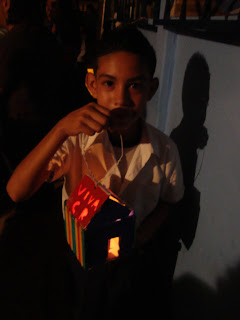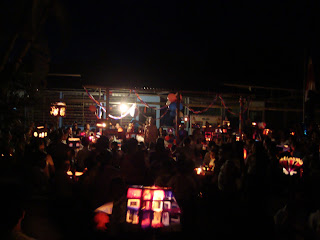One of the core requirements when going through Peace Corps training was learning to cope with cultural adjustment. We were warned about what they refer to as "tico time" and that you can expect when a meeting is scheduled for 2 pm that if you are
lucky it will start at 2:30 pm, but more likely at 3 pm and that presupposes that people actually
show up. As a North American, or more generally we're referred to as "gringo" here, this is one of the most frustrating cultural adjustments that we have to make.
I've heard that the cultural reason behind "tico time" is that ticos place more importance on relationships than they do on being on time. So, if you're a tico and you're hanging out with your brother and it is 2:30 pm and you're supposed to be at someone's house at 3:00 pm and it takes you 30 minutes to drive there, but your brother asks you to stay longer for a cafecito (coffee break or literally "little coffee"), who are you to say no. Meanwhile, your community development meeting is supposed to happen at 3:00 pm and the first person shows up at 3:30 pm and 2 others trickle in. They call you at 4 pm, but cafecito is still happening and you say, sure, you'll be there
ahorita (meaning soonish or sometimes,
never). After 1 1/2 hours of waiting around with the 3 members of the community development leadership and making several calls to see if you can get just one more member to show up, as they need 4 to make a quorum, they decide to cancel the meeting having wasted nearly 4 1/2 hours of cumulative time. Now, I'm generally pretty tolerant of many cultural differences, and believe that a lot of time my culture is too focused on time (or lack thereof) and we end up running around exhausting ourselves all day like chickens with our heads cut off. However, not showing up to a meeting after given a 1 1/2 hour window opportunity is just plain
selfish. It is placing value on your time above the collective time of others.
I also do not buy the cultural argument about placing more value on relationships than other cultures. Sure, there is probably some truth to that. However, when we called the treasurer to the community development association to come to the meeting after waiting for an hour and a half, he was sitting at home doing nothing. He was sitting there waiting for someone else to show up. Nor did he call to give an expectation that he would not show up and even if he did you could not necessarily count on his
ahorita.
Another cultural phenomena that factors into this is that ticos do not like to say no. So, if they can't or just don't want to show up, they just don't do it. When you confront them, they say yes or maybe when they really mean no or most likely not. This method of functioning is supposedly a way of saving face as ticos try everything they can do to avoid conflict. It is one big passive agressive society. So, imagine you have a passive aggressive grandparent, child, mother-in-law or parent that just drives you nuts and multiply that by 4 million and there you have Costa Rica.
Obviously, I exaggerate, but honestly not very much. This cultural phenomena has many serious implications; important projects are delayed for weeks, months and even years (or they just never get done) and it saps the motivation of the groups performing community development and other important work. My hypothesis about tico time is that it has grown out of habit, that in the past there was not reliable transportation and therefore, meetings were cancelled and or never happened at all. I believe that climate also has a factor here as when it rains it makes journeys difficult and sometimes impossible so you have to be a lot more flexible with time. I have to admit also that somedays it is so hot here, I want to sit around here and do nothing except watch and feel my brain slowly melt to the ground. Whereas, you cannot change the weather, transportation has improved dramatically and is no longer an excuse for being late or not showing up. I do have to give it to ticos for their patience and there flexibility though, because if it was up to me, I would have given up a long time ago.
























